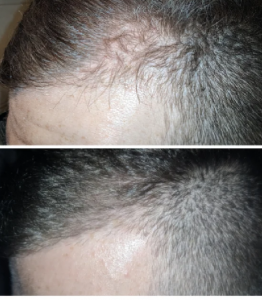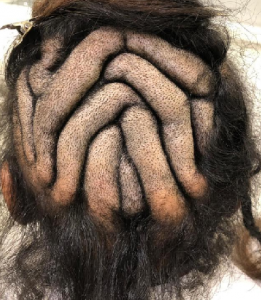Taken from Reddit.com. My comments: We reported this back in 2011 (https://baldingblog.com/does-botox-prevent-or-reverse-hair-loss/). I read through this article and the three references. Thanks for sending this interesting material to me. I do not understand the mechanism here nor do I feel that any good double blind study is available. There is not enough science to make this a dependable treatment but from the 4 publications, I would expect that more information will be available in the future. I wouldn’t want someone to take on Botox instead of a more traditional treatment and then lose their hair while trying this experimental approach as time is the enemy in genetic hair loss so the longer it goes on, the more is lost. I include as much information as possible for my readership to be able to see and understand that may be coming in the future, even if it is more hope than reality.
https://sci-hub.se/10.1016/j.jaad.2020.04.082
Dihydrotestosterone (DHT) induces transforming growth factor-?1 (TGF-?1) in dermal papilla cells (DPC) to suppress follicular epithelial cell growth. Thus, TGF-?1 is one of the key players in androgenetic alopecia (AGA) and its antagonist may prevent AGA Botulinum toxin type A (BTX) may inhibit TGF-?1 secretion from DPCs as it does with scar tissue fibroblasts, which shares the mesenchymal origin. Recently, BTX has been effective for the treatment of AGA.
Herein, we evaluated the efficacy and safety of intradermal injection of BTX (Nabota®, Daewoong Pharmaceutical, Seoul, Korea) in AGA and its relationship with TGF-?1.
AGA patients were enrolled according to the basic and specific classification. Patients undergoing treatment with finasteride, minoxidil or supplements that affect hair growth were excluded. This study was approved by the institutional review board. The participants received intradermal BTX injections every four weeks for 24 weeks. A total of 30 units of BTX were injected at 20 different sites on the balding scalp in each treatment session.
The expression of TGF-?1 from cultured DPCs under 100 nM DHT was evaluated by RT-PCR analysis. Suppression of DHT-induced TGF-?1 secretion from DPCs by BTX (2.5U/106 46 cell) was assessed by immunofluorescence staining. The doses of BTX in the in vitro study were selected on the basis of a previous report investigating the effect of BTX (2.5U/106 cells) on TGF-?1 secretion from the fibroblasts.
This study comprised 18 male patients with mean age 49.00 ± 6.50. In an unblinded phototrichogram image analysis (Lead M Corp, Seoul, Korea), the number of hairs per cm2 at weeks 0, 12, and 24 were 129.61 ± 28.05, 129.11 ± 28.80, and 136.22 ± 33.05, respectively. The number of hairs significantly increased at week 24 (P = 0.012) but not at week 12 (P = 0.803). Comparison of the pre- and posttreatment photographs showed significant improvement at week 24 (P = 0.031) (Fig. 1). DHT upregulated the TGF-?1 expression of DPCs in 96 hours, whereas BTX downregulated the TGF-?1 expression in 96 hours (Fig. 2). No serious adverse events or changes in laboratory parameters were reported.
DHT-induced synthesis of paracrine mediators (Dkk-1, IL-6, TGF-?1) in balding DPCs may play a role in AGA and represent alternative treatment targets. However, clinical studies targeting these paracrine mediators have not been reported. In our in vitro study, BTX successfully abrogated DHT-induced secretion of TGF-?1 from DPC.
Intradermal injection of BTX was effective against AGA by inhibiting TGF61 ?1 secretion in the hair bulb, which is thought to suppress follicular keratinocyte growth and changes in the hair cycle. Previous studies reported the use of intramuscular BTX injections to treat AGA without elucidating the exact underlying mechanism. Considering the diffusion of the injected liquid BTX and scalp anatomy, even the intramuscular injection may indirectly inhibit the secretion of TGF-?1 from DPCs in the hair bulb. Advanced AGA or elderly age may have adversely influenced our treatment outcome.
In conclusion, we suggest that intradermal injection of botulinum toxin could be a possible treatment option for AGA by inhibiting TGF-?1 secretion from the hair follicles. However, further research and long-term follow-up are required.
Some more botox related info
A Pilot Study to Evaluate Effectiveness of Botulinum Toxin in Treatment of Androgenetic Alopecia in Maleshttps://www.ncbi.nlm.nih.gov/pmc/articles/PMC5782443/
A small dose of botulinum toxin A is effective for treating androgenetic alopecia in Chinese patientshttps://sci-hub.se/10.1111/dth.12785
Treatment of Male Pattern Baldness with Botulinum Toxin: A Pilot Studyhttps://journals.lww.com/plasreconsurg/fulltext/2010/11000/Treatment_of_Male_Pattern_Baldness_with_Botulinum.79.aspx




